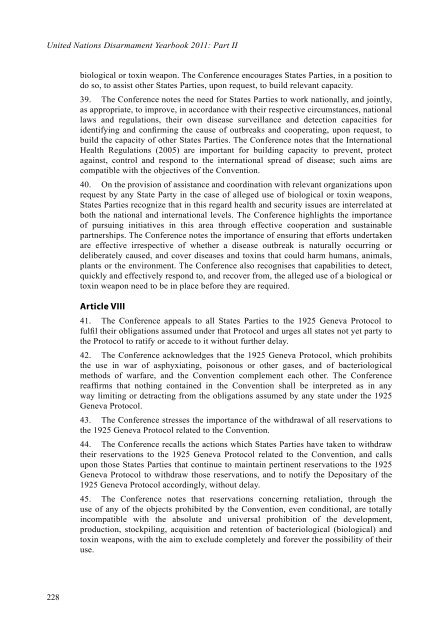DYB2011-Part-II-web
DYB2011-Part-II-web
DYB2011-Part-II-web
You also want an ePaper? Increase the reach of your titles
YUMPU automatically turns print PDFs into web optimized ePapers that Google loves.
United Nations Disarmament Yearbook 2011: <strong>Part</strong> <strong>II</strong><br />
228<br />
biological or toxin weapon. The Conference encourages States <strong>Part</strong>ies, in a position to<br />
do so, to assist other States <strong>Part</strong>ies, upon request, to build relevant capacity.<br />
39. The Conference notes the need for States <strong>Part</strong>ies to work nationally, and jointly,<br />
as appropriate, to improve, in accordance with their respective circumstances, national<br />
laws and regulations, their own disease surveillance and detection capacities for<br />
identifying and confirming the cause of outbreaks and cooperating, upon request, to<br />
build the capacity of other States <strong>Part</strong>ies. The Conference notes that the International<br />
Health Regulations (2005) are important for building capacity to prevent, protect<br />
against, control and respond to the international spread of disease; such aims are<br />
compatible with the objectives of the Convention.<br />
40. On the provision of assistance and coordination with relevant organizations upon<br />
request by any State <strong>Part</strong>y in the case of alleged use of biological or toxin weapons,<br />
States <strong>Part</strong>ies recognize that in this regard health and security issues are interrelated at<br />
both the national and international levels. The Conference highlights the importance<br />
of pursuing initiatives in this area through effective cooperation and sustainable<br />
partnerships. The Conference notes the importance of ensuring that efforts undertaken<br />
are effective irrespective of whether a disease outbreak is naturally occurring or<br />
deliberately caused, and cover diseases and toxins that could harm humans, animals,<br />
plants or the environment. The Conference also recognises that capabilities to detect,<br />
quickly and effectively respond to, and recover from, the alleged use of a biological or<br />
toxin weapon need to be in place before they are required.<br />
Article V<strong>II</strong>I<br />
41. The Conference appeals to all States <strong>Part</strong>ies to the 1925 Geneva Protocol to<br />
fulfil their obligations assumed under that Protocol and urges all states not yet party to<br />
the Protocol to ratify or accede to it without further delay.<br />
42. The Conference acknowledges that the 1925 Geneva Protocol, which prohibits<br />
the use in war of asphyxiating, poisonous or other gases, and of bacteriological<br />
methods of warfare, and the Convention complement each other. The Conference<br />
reaffirms that nothing contained in the Convention shall be interpreted as in any<br />
way limiting or detracting from the obligations assumed by any state under the 1925<br />
Geneva Protocol.<br />
43. The Conference stresses the importance of the withdrawal of all reservations to<br />
the 1925 Geneva Protocol related to the Convention.<br />
44. The Conference recalls the actions which States <strong>Part</strong>ies have taken to withdraw<br />
their reservations to the 1925 Geneva Protocol related to the Convention, and calls<br />
upon those States <strong>Part</strong>ies that continue to maintain pertinent reservations to the 1925<br />
Geneva Protocol to withdraw those reservations, and to notify the Depositary of the<br />
1925 Geneva Protocol accordingly, without delay.<br />
45. The Conference notes that reservations concerning retaliation, through the<br />
use of any of the objects prohibited by the Convention, even conditional, are totally<br />
incompatible with the absolute and universal prohibition of the development,<br />
production, stockpiling, acquisition and retention of bacteriological (biological) and<br />
toxin weapons, with the aim to exclude completely and forever the possibility of their<br />
use.


